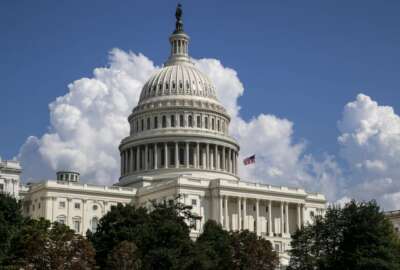
What’s driving federal IT, acquisition in 2019 and beyond? PSC has the forecast
The Professional Services Council released its 54th annual Vision Forecast to industry and found agencies expect budgets to tighten in 2020 and beyond.
Agencies may just remember fiscal years 2017 through 2019 as the best of times. Money was flush — generally speaking — with some agencies actually not being able to spend everything they received in 2018. Congress and the president actually got spending bills done almost on time and not six months into the fiscal year. The threat of shutdown was minor.
So as agencies finalize their 2020 budget requests—agency passback guidance usually is ready by Thanksgiving—there is a real expectation that the “do more with less” mantra will return in force.
The evidence, at least for now, is coming from multiple places. First, President Donald Trump announced he would ask each agency for a 5 percent budget cut in 2020. Deputy Defense Secretary Pat Shanahan said last week at the Military Reporter’s Conference that the Defense Department is developing two budget requests, one without the 5 percent cut and one with it.
“The way I would think about those two budgets and the approach — there are certain things that you can’t change. There are near term costs that we are going to expend in the next year that are on contract and for all intent and purposes are fixed,” Shanahan said. “There are other investments that we will make in science and technology and procurement and we have knobs in terms of timing. The exercise we are going through is there is prioritization we can make. We have a number of options going on with hypersonic missiles. In these projects we can decide to do them or to defer them.”
Shanahan said he is working with the DoD comptroller and the Office of Cost Assessment and Program Evaluation (CAPE) team on what projects could be deferred, and then Secretary James Mattis will make a decision based on those trade offs.
Second is the feeling on the ground. For that, just look at the comments and expectations coming from the Professional Services Council’s 54th annual Vision Forecast. In interviews with hundreds of federal technology and acquisition officials and in analyzing spending data, PSC’s team of industry volunteers found 2019 is likely to be the “high water mark” for spending.
“There are couple of things that caused the team to look at that. Number one, is the sheer magnitude of the federal budget and the challenges we are facing in the next few years in terms of deficits, interest payments and the outlook for economic growth coming up here all tend to indicate we have about as much headroom in the budget as we can possibly stand right now,” said Lou Crenshaw, a Vision volunteer and team lead for the DoD topline and macroeconomic research. “We are starting to see pressure from OMB and other places for people to begin to reduce spending. I think part of that is the realization that we have some real serious problems we will have to deal with. I think the topline will stay the same and there may be movement between defense and non-defense because of the security situation.”
Now, of course, all of this good feeling about budget and shutdown threats could change in November if the House and/or Senate switches parties. Oh and that nasty “s” word — sequestration — could return in 2020 and beyond if Congress doesn’t raise the spending caps.
The PSC Vision Forecast — for those of you who can still make the annual conference it takes place Monday and Tuesday in Falls Church, Virginia —offered several other significant trends around technology and acquisition for 2019 and beyond. Here are just a few that stood out:
Services remain king
The PSC team found agencies expect to continue to increase spending on knowledge-based services and IT services spending continues to see a steady growth. But the biggest difference this year than in past surveys is the discussion around mission priorities.
“In past we’ve seen a lot of emphasis on support services, but not necessarily driving toward how they support the overall mission for the agency,” Kirste Webb, the Vision civilian chairwoman. “One of the biggest messages we are hearing across the board is that all of the agencies are now shifting to everything is about their mission, and if procurement or acquisition is not directly supporting that mission they are taking a second look at how it’s being procured and what’s being done with it.”
Webb said agencies are looking at alternative contracting practices such as Other Transaction Authority (OTAs), best-in-class contracts and sole source awards with a goal of getting to the market faster and bringing innovation to help meet mission goals better.
Interestingly, the use of shared services did not come up as an alternative or even as an option agencies are seriously considering.
O&M equals operations and modernization
The Office of Management and Budget is entering is fourth year where IT modernization is its top priority because of how everything from cybersecurity to citizen services to workforce branch off from it.
The PSC team found the discussion on IT modernization shifted from straight numbers highlighting technical debt or continued support of legacy systems to managing the IT modernization.
“It’s really about Technology Business Management. We’ve seen that changes are being attempted at an unprecedented scale across the federal enterprise. It’s going to improve the quality of the data. These are culture challenges that are extremely daunting but the outlook is promising,” said Steve Vetter, one of the two federal IT and budget Vision chairmen.
Greg Lobbin, the other federal IT and budget Vision chairman, said agencies seen an opportunity because of cloud computing to use operational expenditures (OpEx) for modernization efforts.
This may be part of the reason the impact of the Modernizing Government Technology (MGT) Act is slow to materialize. Agencies are finding ways to modernize without the need to apply for a loan from the Technology Modernization Fund, or by setting up a working capital fund.
A changing industry, government relationship
One of the most positive changes that came from the discussions with agencies is the desire for a better working relationship with contractors.
Webb said the cautious message coming from the government is how can industry and government work to evolve the mission together.
“I think what we are seeing is agencies are trying to get industry involved earlier to avoid what’s been happening which are a lot of protests during the acquisition process. We are seeing an increased exchange across the civilian agencies in terms of industry days, industry exchanges, one-on-one opportunities well in advance of a final solicitation coming out as part of the critical steps in trying to partner more with industry across the board,” she said. “Once the acquisition is complete and a contractor is in place, agencies are recognizing working together is far better to achieve the mission.”
Webb said partnership agreements, such as those used extensively by the Department of Energy, are becoming more common.
“What we are seeing is rather than trying to fight against each other, we are seeing more going toward working with each other to resolve challenges that may occur and trying to identify potential risks and how to solve those risks before they even occur,” she said.
The best and most well-known examples of the change that PSC is highlighting are the IRS’ reverse industry days, the Homeland Security Department’s Procurement Innovation Lab’s efforts and the General Services Administration’s interact site.
4 forces driving federal acquisition
Of all the trends that emerged from the 22 study teams, which conducted more than 300 interviews, the drivers of federal acquisition became clear.
Alan Chvotkin, PSC’s executive vice president and general counsel, said the President’s Management Agenda cross-agency goals continue to be the North Star that agencies are heading toward. But that also means a few other things including a tightening of the market for some vendors and an increased set of opportunities for others, particularly those in the cybersecurity and IT modernization.
“There is no doubt increased focus on IT. Cybersecurity is clearly a high risk and high spend area so we think there will be a lot of business opportunities,” he said.
Agencies are continuing to emphasize and push toward commercial services and nontraditional contractors. But, Chvotkin said, there is a mixed message because agencies also want to push government unique requirements down into the supply chain security and security clearances.
Finally, the competition for workforce talent will remain strong among industry and government alike.
Read more of the Reporter’s Notebook
Copyright © 2025 Federal News Network. All rights reserved. This website is not intended for users located within the European Economic Area.
Jason Miller is executive editor of Federal News Network and directs news coverage on the people, policy and programs of the federal government.
Follow @jmillerWFED
Related Stories






